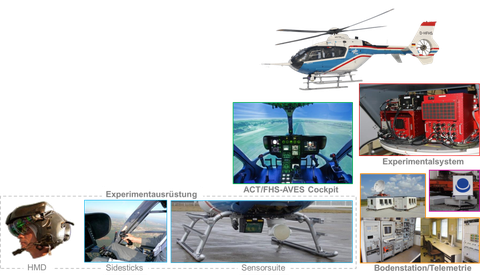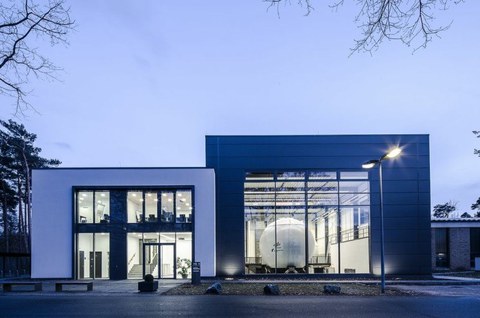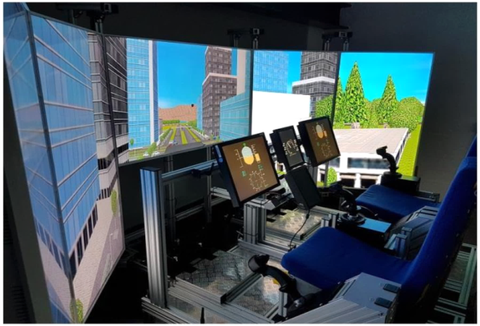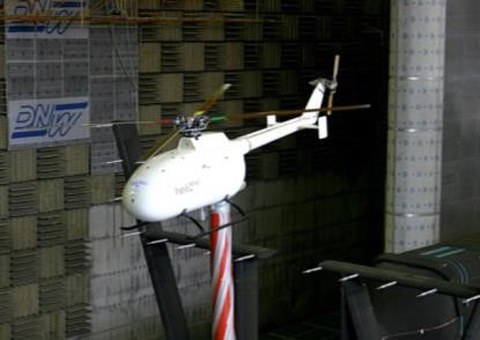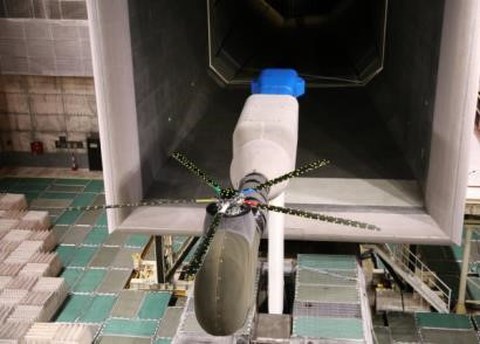Large-scale Facilities
Various large-scale research facilities are available to the department for the research content described in the research focus.
Table of contents
Active Control Technology/Flying Helicopter Simulator (ACT/FHS)
The ACT/FHS is an EC135 helicopter converted by Airbus Helicoters and Liebherr-Aerospace Lindenberg, the “Bundesamt für Ausrüstung, Nutzung und Information der Bundeswehr” and DLR. The mechanical flight control system has been replaced by a fly-by-wire/fly-by-light flight control system. Instead of control rods, electric cables and glass fibre optic cables now transmit the control commands. The ACT/FHS is equipped as standard with two engines, a bearingless main rotor and a Fenestron tail rotor; it is characterised by particularly quiet operation, high manoeuvrability and safety. The modified flight control system in combination with the experimental system gives freedom to researchers to control the helicopter by means of an automatic flight control system developed by customers or DLR. One aspect ist to reduce workload of pilots. This ranges from simple flight control tasks to fully automatic guidance of the helicopter and describes the first name addition "ACT". With this technology, however, the behaviour of the original helicopter can also be manipulated such that the pilot believes he is flying a different helicopter (inflight simulation). This is where the second name suffix "FHS" is derived from. The modified basic helicopter has a maximum take-off weight of 2. 835kg and a rotor diameter of 10.2m. It comprises an experimental system for recording measurement data and controlling the experiments, a telemetry system for transmitting data to a ground station with corresponding equipment and for communicating with the helicopter crew. Extensive experimental equipment (Helmet Mounted Display (HMD) for displaying information to the pilot, active sidesticks, see above, and environment scanning sensors like lidar, radar, IR and TV camera) complement this tes aircraft.
Further information regarding the ACT/FHS can be found on the DLR home page.
Air Vehicle Simulator (AVES)
The national centre for flight simulation in aeronautics research AVES (Air VEhicle Simulator) consists of two high-quality facilities for the simulation of aircraft and helicopters. AVES is designed as a modular, flexible platform and closes the gap between numerical flight physics simulation and experimental flight operations at DLR in Braunschweig. AVES is operated by the Institute of Flight Systems. Focus is research on the dynamic interaction between humans and aircraft. AVES has a fixed simulator position and a position with an electromechanically driven motion system. This provides the best closeness to reality for cockpit crews. Two visual systems with 15 LED projectors each provide a field of view of 240° x 95°. Currently, the AVEs has simulation cockpits for an Airbus A320 and an Airbus Helicopters EC135 in Level D quality. These cockpits represent DLR's flying test vehicles ATRA and ACT/FHS in the best possible way.
A sophisticated system allows a change of cockpits from the fixed simulator to the motion simulator and back within a few hours. More than 50 computers and several kilometers of data cables ensure the necessary exchange of information between the systems. In addition to the exact replication of the pilots' workplaces, a seat for a flight test engineer (FTI) and another observer seat are installed in the EC135 cockpit. The AVES is used, among other things, to prepare experiments with the ACT/FHS, e.g. to instruct the pilots on upcoming flight experiments. Since it also has the same experimental system as the ACT/FHS, preliminary tests are carried out in the AVES before each flight with new flight controllers in order to avoid unnecessary flight tests due to faulty software, but also to ensure flight safety. If these software tests have been passed successfully, the bit-identical software can be transferred to the ACT/FHS to be tested in flight. In addition, the AVES has now become more and more of a research facility in its own right. This concerns, for example, flights in reduced visibility, flights in maritime environments such as wind farms, where the ACT/FHS is not allowed to fly for safety reasons, or the tuning of the motion platform itself. The pilot seat of the AVES can be equipped with the same flight-capable active sidesticks as the ACT/FHS.
Further information for AVES can be found on the DLR home page.
Dual Pilot Active Sidestick Demonstrator (2PASD)
The generic helicopter flight simulator 2PASD (Dual Pilot Active Sidestick Demonstrator) was built for supplementary research that required both pilot seats to be equipped with active sticks. 2PASD not only has two pilot workstations, each with active sidesticks for collective and cyclic control, but also active pedals for control of the yawing axis. The active sticks of the two pilot workstations can be electronically coupled and decoupled. In coupled mode, they behave as if they were connected by mechanical linkages. The external view is displayed on five screens arranged side by side. Two touch screens are available for the instrument panel of each pilot. 2PASD has a modular design and can therefore be easily modified and also used in mobile applications. Programming is done with common development tools such as Matlab/Simulink. 2PASD is especially used for for research on variable control coupling of the sticks, but also for developing tactile cueing functions as well as for their demonstration and evaluation with pilots.
Rotor Test Rigs for Wind Tunnel Tests
DLR's rotor test rigs consist of the two test rigs MWM and ROTEST. MWM is a modular wind tunnel model structure with reduced dimensions for testing entire rotorcraft models in the wind tunnel. In addition to the main rotor and a realistic fuselage, the tail rotor of a corresponding helicopter can also be tested in this way. The fuselage covers the wind tunnel model structure with its balance, rotary transducers from rotor to the stationary system, hydraulic drive etc. In addition, a more robust and larger rotor test rig ROTEST is used, which, due to its robustness, is primarily used for testing new technologies such as active rotor control. Here, the fuselage is usually an acoustically damped fairing, which then no longer allows testing of whole configurations. Both test stands are supplemented by appropriate hydraulic power units and special measurement data acquisition systems.
Both systems allow testing of either entire helicopter configurations or rotors up to approx. 4.2m rotor diameter and 190kW propulsion power in the DNW-LLF (German-Dutch Wind Tunnels - Large Low Speed Facility). Fuselage fairing and blades can be highly instrumented, sometimes with more than 120 sensors (dynamic pressure and strain sensors) in one blade. In addition, highly precise balances provide up to 6 loads for main and tail rotor and possibly other components such as wings. The elastic deformations of the blades can be measured with high precision by Cameras (Stereo Pattern Recognition) by applying optical markers on the blades. Different microphones allow measurements of noise emitted by the rotor in or below the rotor plane. Furthermore, certain technologies such as PIV and BOS (Particle Image Velocimetry, Background-Oriented Schlieren) can be used to make flow phenomena visible. The rotor test rig group, which has spent more than 2200 test hours in the wind tunnel since 1973, is unique in Europe in combination with the DNW-LLF. Currently, a smaller model with a rotor diameter of 1.6m is being built for the Low Speed Wind Tunnel (NWB) in Braunschweig. The test stands are used for research in dynamics, aerodynamics, rotor wake, vortex geometry or high-precision noise measurement, e.g. to provide measurement data for simulation code validation, but also for phenomenological research in principle, testing of new rotorcraft configurations as well as testing of active rotor control for vibration and noise reduction and performance improvement.
Further information can be found the DLR home page.
Icing Laboratory
For research on de-icing systems for rotorcraft, an icing laboratory is currently being set up as part of a project funded by the German government, in which full scale rotor blade segments or model rotor blades up to a radius of approx. 2m can be exposed to icing conditions under centrifugal force in order to test innovative de-icing systems.
Research Wind Farm
For research on wind turbines, DLR is currently also setting up its own research wind farm with highly instrumented wind turbines. This will also be available for the two above-mentioned goals in the field of wind energy.

